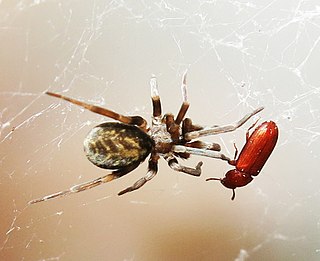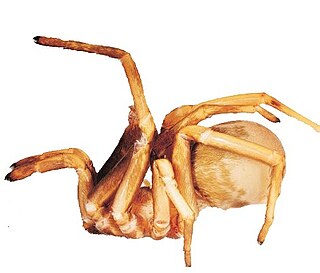
Ground spiders comprise Gnaphosidae, the seventh largest spider family with over 2,000 described species in over 100 genera distributed worldwide. There are 105 species known to central Europe, and common genera include Gnaphosa, Drassodes, Micaria, Cesonia, Zelotes and many others. They are closely related to Clubionidae. At present, no ground spiders are known to be seriously venomous to humans.

Ant spiders are members of the family Zodariidae. They are small to medium-sized eight-eyed spiders found in all tropical and subtropical regions of South America, Africa, Madagascar, Australia-New Guinea, New Zealand, Arabia and the Indian subcontinent. Most species are daytime hunters and live together with ants, mimicking their behavior and sometimes even their chemical traits. Although little is known about most zodariids, members of the genus Zodarion apparently feed only on ants; a number of other genera in the family are apparently also ant specialists.

Liocranidae is a family of araneomorph spiders first described by Eugène Simon in 1897. They are one of several groups called "sac spiders". The holarctic genus Agroeca is the best-known, but it also includes various genera of more obscure spiders that still lack a diagnosis. Two species in the North American genus Neoanagraphis are found in the extremely dry conditions in the Mojave, Sonoran and Chihuahuan deserts. Females live in animal burrows while males wander and are the ones most often caught in pitfall traps.

Tegenaria is a genus of fast-running funnel weavers that occupy much of the Northern Hemisphere except for Japan and Indonesia. It was first described by Pierre André Latreille in 1804, though many of its species have been moved elsewhere. The majority of these were moved to Eratigena, including the giant house spider and the hobo spider.

Araniella is a genus of orb-weaver spiders first described by R. V. Chamberlin & Wilton Ivie in 1942.
Filistata is a genus of crevice weavers that was first described by Pierre André Latreille in 1810.

Pritha is a genus of crevice weavers that was first described by Pekka T. Lehtinen in 1967.

Sahastata is a genus of crevice weavers that was first described by Pierre L.G. Benoit in 1968.
Agelescape is a genus of funnel weavers first described by G. Levy in 1996.
Paracedicus is a genus of Asian araneomorph spiders in the family Cybaeidae, and was first described by Victor R. Fet in 1993. First placed as a subgenus of Cedicus, it was elevated to genus status in 2003.
Mesiotelus is a genus of spiders in the family Liocranidae. It was first described in 1897 by Eugène Simon.
Cryptodrassus is a genus of ground spiders that was first described by F. Miller in 1943.
Pterotricha is a genus of ground spiders that was first described by Władysław Kulczyński in 1903.

Bassaniodes is a genus of crab spiders that was first described by Reginald Innes Pocock in 1903.
Lachesana is a genus of spiders in the family Zodariidae. It was first described in 1932 by Strand. As of 2022, it contains 11 species.
Rhysodromus is a genus of spiders in the family Philodromidae. It was first described in 1965 by Schick. As of 2022, it contains 28 species.
Gorbiscape is a small genus of funnel weavers. It was first described by Alireza Zamani and Yuri M. Marusik in 2020, and it has only been found in Tajikistan. As of November 2021 it contains only two species: G. agelenoides and G. gorbachevi.
Persiscape is a genus of funnel weavers first described by Alireza Zamani and Yuri M. Marusik in 2020.
Marinarozelotes is a genus of ground spiders first described by A. V. Ponomarev and V. Y. Shmatko in 2020. The type species, Marinarozelotes barbatus, was originally described under the name "Melanophora barbata".







